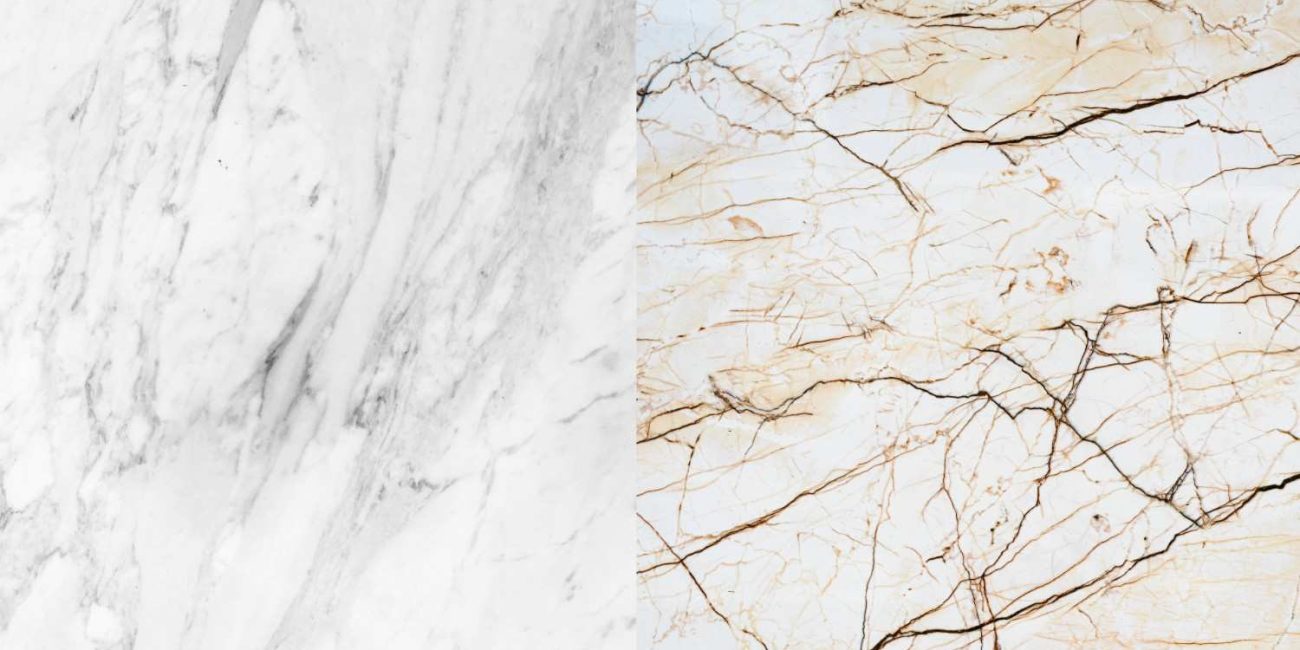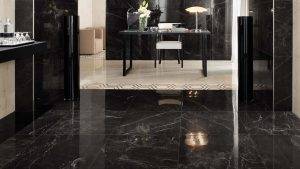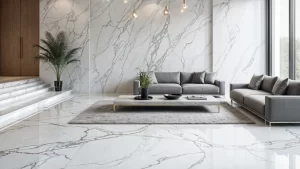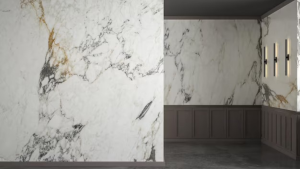Marble has long been synonymous with luxury and timeless beauty, making it a preferred choice in both historical and contemporary architecture. Quarried from natural sources, this elegant stone has adorned everything from grand palaces to modern homes, offering a wide variety of colours and unique veining. With advancements in technology, artificial marble has become a strong alternative, providing similar aesthetics with added durability and cost efficiency.
The debate between artificial marble and natural marble revolves around factors like durability, maintenance, and cost. Natural marble boasts distinctive veining and rich history, while artificial marble offers a more uniform look with better stain resistance and lower upkeep. Choosing between the two depends on aesthetic preferences and functional needs.
In this article, we explore the key differences between these marble types, helping you make an informed decision for your next project—whether it’s for a kitchen countertop, bathroom vanity, or statement flooring—straight from insights provided by a trusted marble factory.
What is Artificial Marble?
Artificial marble, also known as engineered marble, is a man-made product designed to look like natural marble. It’s created by combining marble dust, resins, and colouring agents, all mixed and hardened into slabs. This process allows for the creation of a wide range of colours and patterns, all while maintaining a consistent quality that is hard to achieve with natural marble.
How is Artificial Marble Made?
- Mixing: Manufacturers mix crushed marble stone with polymer resins and pigments.
- Moulding: The mixture is then poured into moulds to form slabs or tiles.
- Curing: These moulds are subjected to heat and pressure to cure and solidify, mimicking the appearance of natural marble.
- Polishing: Finally, the surfaces are polished to achieve a glossy finish.
Benefits of Artificial Marble
Exploring the advantages of using artificial marble can help you decide if it’s the right choice for your home.
Why Choose Artificial Marble?
- Durability: Artificial marble is generally more durable than natural marble, resisting chips and scratches.
- Low Maintenance: Unlike natural marble, it doesn’t require regular sealing to prevent stains.
- Cost-Effective: It often comes at a lower price point than natural marble.
- Consistent Appearance: Provides a uniform look that ensures design continuity in large spaces.
Comparison Table:
| Feature | Artificial Marble | Natural Marble |
| Durability | High uniform strengthLess prone to chipping and cracking | Durable but susceptible to scratches and etchingRequires careful handling |
| Cost | More cost-effective due to manufactured natureLower mining and transportation costs | Higher costs due to quarrying and transportationConsidered a premium material |
| Maintenance | Easy to maintain with regular cleaningNon-porous surface reduces stain risks | Requires regular sealing to prevent stainsSensitive to acidic substances and cleaners |
| Aesthetic Variability | Consistent patterns and coloursIdeal for large areas needing uniform appearance | Unique patterns and colours in each slabOffers bespoke natural beauty |
| Pros | Economical and readily availableLow maintenance and stain-resistantVersatile applications | Unique aesthetic with natural veiningAdds to property valueNaturally cool surface |
| Cons | May look synthetic, lacking the unique beauty of natural stoneLower addition to property value | Higher initial and maintenance costsProne to staining and etching without proper care |
What is Natural Marble?
Natural marble is a beloved and luxurious material formed over thousands of years under the earth’s surface. This metamorphic rock originates from limestone that has been subjected to intense heat and pressure, causing it to crystallize and develop its characteristic veins and swirls. Each piece of natural marble is one-of-a-kind, bearing unique patterns and hues that make it a favourite in high-end designs.
How Natural Marble Forms
- Origin: Begins as limestone or dolomite that undergoes metamorphosis.
- Transformation: The presence of intense heat and pressure causes the stone to recrystallize, forming natural marble.
- Veining: Minerals such as clay, sand, iron oxides, and others within the stone give natural marble its distinctive veins.
- Extraction: Finally, marble is quarried in large blocks and then cut into slabs or tiles, ready for use in various projects.
The Appeal of Natural Marble
Natural marble isn’t just another building material; it’s a slice of Earth’s history, each piece telling its own geologic story.
Why Choose Natural Marble?
- Uniqueness: No two slabs of natural marble are the same, giving a unique aesthetic to every space.
- Luxury Appeal: Its natural beauty adds an element of sophistication and luxury that is hard to replicate.
- Cool Temperature: Marble remains cool naturally, making it an excellent choice for warm climates.
- Longevity: If properly maintained, natural marble can last for decades, even centuries, adding value to property over time.
Comparing Artificial and Natural Marble
Understanding the key differences between artificial and natural marble helps in making the right choice for interior and exterior design. Here’s a quick comparison:
- Durability: Artificial marble is strong and less prone to chipping, while natural marble is durable but requires careful handling.
- Cost: Artificial marble is more affordable due to lower mining and processing costs, whereas natural marble is a premium material with higher quarrying expenses.
- Maintenance: Artificial marble is easy to clean and non-porous, while natural marble needs regular sealing and is sensitive to acidic cleaners.
- Aesthetic Appeal: Artificial marble offers uniform colours and patterns, making it ideal for large projects, while natural marble provides unique veining and a timeless, luxurious look.
The choice depends on budget, maintenance preference, and design goals. For high-quality options, explore Granite & Marble supplier in UAE offering both artificial and natural marble solutions.
Pros and Cons of Artificial and Natural Marble
Understanding the benefits and drawbacks of both types helps in making the right choice.
Pros of Artificial Marble:
- Affordable and widely available.
- Uniform appearance with no unexpected variations.
- Low maintenance and stain-resistant.
- Versatile for flooring, walls, and countertops.
Cons of Artificial Marble:
- Lacks the natural beauty of real stone.
- May look synthetic to some.
- Adds less property value compared to natural marble.
Pros of Natural Marble:
- Unique patterns and colours in every slab.
- Luxurious and elegant, enhancing property value.
- Naturally cool, ideal for warm climates.
Cons of Natural Marble:
- More expensive due to quarrying and transportation.
- Requires regular maintenance and sealing.
- Prone to staining and etching.
Choosing between artificial and natural marble depends on budget, maintenance preferences, and design goals—artificial marble offers practicality, while natural marble delivers timeless elegance.
Choosing the Right Marble for Your Needs
Selecting between artificial and natural marble depends on budget, usage, maintenance, and environmental factors.
- Budget: Artificial marble is cost-effective with versatile designs, while natural marble suits those willing to invest in unique aesthetics and long-term value.
- Usage: Artificial marble is ideal for high-traffic areas like commercial floors and kitchens, while natural marble works best in luxury spaces with minimal wear.
- Maintenance: Artificial marble requires little upkeep, while natural marble needs sealing and careful cleaning to maintain its elegance.
- Environment: Artificial marble adapts well to different conditions, whereas natural marble is best in stable climates without extreme temperature shifts.
By considering these factors, you can choose marble that balances beauty and functionality, ensuring a durable and stylish addition to your space.
Installation and Maintenance Tips
Proper installation and maintenance are crucial for maximizing the longevity and beauty of both artificial and natural marble. Here are some actionable tips and best practices to ensure that your marble installation remains pristine and functional over time.
Installation Tips
General Preparation:
- Ensure the surface area is completely level and clean before installation.
- Use the right adhesive recommended for the marble to avoid staining or discolouration.
Artificial Marble:
- Can be cut and adjusted on-site with more ease than natural marble, which may be beneficial for complex designs.
- Ensure that all pieces are from the same production batch to avoid colour and pattern discrepancies.
Natural Marble:
- Requires more careful handling during installation due to its susceptibility to breakage.
- Consider hiring a professional with experience in natural stone to manage the installation, as natural marble can be quite heavy and fragile.
Maintenance Tips
General Care:
- Use coasters under all glasses and bottles to prevent etching and stains.
- Wipe up spills immediately to avoid potential damage, especially on natural marble.
Cleaning:
- Use a soft cloth and warm water for daily cleaning; avoid harsh chemicals and acidic cleaners that can etch the surface.
- For both types of marble, a mild detergent or stone soap can be used periodically, but rinse thoroughly to prevent film build-up.
Artificial Marble:
- Although it is more resistant to staining, regular cleaning is still recommended to maintain its appearance.
- Avoid placing hot items directly on the surface as the resin components can be damaged by high temperatures.
Natural Marble:
- Requires sealing upon installation and periodically thereafter, depending on the level of use and exposure to elements.
- Use sealants recommended specifically for natural stone; these will help create a barrier that resists stains and facilitates easier cleaning.
Long-Term Care
Periodic Assessments:
- Regularly check both types of marble for any signs of wear or damage. Addressing issues early can prevent costly repairs.
- Re-polish the surface every few years to renew its shine and protective coating, especially for natural marble.
Proper care and maintenance keep both artificial and natural marble looking beautiful and long-lasting. By following these tips, you can preserve their durability and aesthetic appeal for years to come. For high-quality materials and expert guidance, consider sourcing from a trusted granite supplier in the UAE.
Conclusion
Both artificial and natural marble offer unique benefits, making them ideal for different needs. Artificial marble is durable, low-maintenance, and budget-friendly, perfect for high-traffic areas and modern designs. Its consistent patterns provide versatility without compromising aesthetics.
Natural marble, on the other hand, features timeless beauty, unique veining, and rich textures that add elegance and value to any space. Though it requires more maintenance, its luxurious appeal makes it a worthwhile investment.When choosing between artificial marble vs natural marble, consider your budget, maintenance preferences, and design goals. Both options enhance interiors, and selecting the right one ensures long-lasting beauty and functionality. For high-quality materials, consult a top granite & marble supplier to find the best fit for your space.
Frequently Asked Questions
What is artificial marble?
Artificial marble is a man-made stone created by mixing marble dust, cement, resins, or pigments. It looks like natural marble but is more affordable and often easier to maintain.
What is synthetic marble?
Synthetic marble is another name for artificial marble. It is produced in factories using crushed stone and chemicals, designed to imitate the beauty of natural marble at a lower cost.
What is natural marble?
Natural marble is a real stone formed in the earth from limestone under heat and pressure. It is valued for its unique patterns, strength, and timeless beauty, making it popular for flooring, countertops, and decor.
Difference between original and artificial marble?
Original marble is a natural stone with unique, irregular veins and higher durability but requires sealing and is more expensive. Artificial marble is man-made from marble powder and resins, has uniform patterns, is easier to maintain, and is usually more affordable.
How to identify artificial marble?
Artificial marble shows consistent patterns, feels less cool to the touch, is lighter, smoother, and more flawless compared to natural marble. It is also generally lower in cost.






